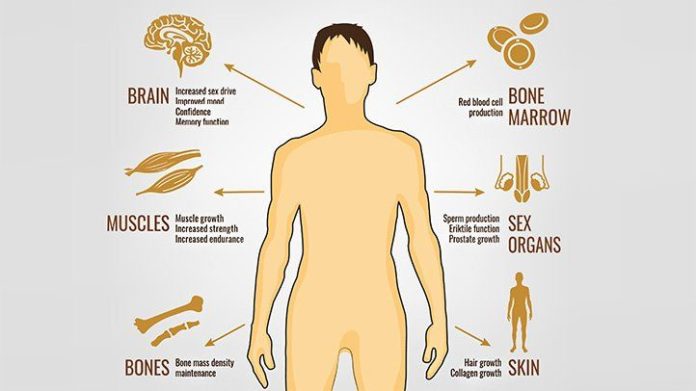RELATED: Testosterone Therapy in Women: Experts Issue First Global Position Statement on Benefits and Risks
Causes and Risk Factors of Low Testosterone
A variety of other medical conditions can cause significantly lower-than-normal testosterone levels in boys and men. These include:
- Autoimmune diseases
- Chronic liver or kidney disease
- Chronic obstructive lung disease
- Genetic causes
- Heart failure
- HIV or AIDS
- Infections (such as mumps)
- Injury to the testicles
- Metabolic disorders
- Obesity
- Prolactinoma (prolactin-secreting tumor) or other tumors in the pituitary gland
- Testicular cancer or treatment for testicular cancer
- Type 2 diabetes
Some drugs are also associated with low testosterone levels, including:
- Alcohol
- Chemotherapy drugs used to treat cancer
- Corticosteroids (sometimes called glucocorticoids)
- Opioids
Sometimes the cause of low testosterone in a man is unknown, and many men have several different causes.
Duration of Low Testosterone
Complications of Low Testosterone
Various medical conditions can cause significantly lower-than-normal testosterone levels in males. These include:
- Autoimmune diseases
- Chronic liver or kidney disease
- Chronic obstructive lung disease
- Genetic causes
- Heart failure
- HIV or AIDS
- Infections
- Injury to the testicles
- Metabolic disorders
- Obesity
- Prolactinoma (prolactin-secreting tumor) in the pituitary gland
- Testicular cancer or treatment for testicular cancer
- Type 2 diabetes
Related Conditions and Causes of Low Testosterone
As listed above (see Causes and Risk Factors of Low T), many conditions, such as obesity or heart failure, relate to or potentially contribute to low T.
Resources
Partnership for the Accurate Testing of Hormones (PATH)
PATH formed in 2010 to help the clinical, medical, and public health communities improve patient care through more accurate and reliable hormone tests. PATH supports research that improves the diagnosis and treatment of hormone disorders, including a landmark 2017 study that defines the “normal” range of testosterone in young adult men.
Dr. Turek’s Blog, The Turek Clinic
Paul Turek, MD, a urologist in San Francisco, is an international leader in male fertility research. He blogs about men’s health topics, including steroids, testosterone, and male infertility, on the Turek Clinic’s website.
Clinical Trials
If you would like to know more about testosterone clinical trials, check ClinicalTrials.gov.
Editorial Sources and Fact-Checking
References
- Testosterone. MedlinePlus. June 4, 2018.
- Low Testosterone — Symptoms. The Urology Care Foundation. July 2020.
- Low Testosterone: Male Hypogonadism. Cleveland Clinic Today. April 10, 2018.
- What Is Low Testosterone? Urology Care Foundation. July 2020.
- Low Testosterone Consultation Information. Urology Austin. May 2018.
- Sexual Health. Mayo Clinic. April 4, 2020.
- 7. FDA Drug Safety Communication: FDA Cautions About Using Testosterone Products for Low Testosterone Due to Aging; Requires Labeling Change to Inform of Possible Increased Risk of Heart Attack and Stroke With Use. U.S. Food and Drug Administration. February 26, 2018.
- Araujo AB, Esche GR, Kupelian V, et al. Prevalence of Symptomatic Androgen Deficiency in Men. The Journal of Clinical Endocrinology and Metabolism. November 2007.
- Kumar P, Kumar N, Thakur DS, Patidar A. Male Hypogonadism: Symptoms and Treatment. Journal of Advanced Pharmaceutical Technology and Research. July–September 2010.
- Qaseem A, Horwitch C, Vijan S, et al. Testosterone Treatment in Adult Men With Age-Related Low Testosterone: A Clinical Guideline From the American College of Physicians Annals of Internal Medicine. January 21, 2020.
- Islam RM, Bell RJ, Green S, et al. The Lancet Diabetes and Endocrinology. July 25, 2019
Sources
Low Testosterone (Hypogonadism). Hormone Health Network. April 2020.













































